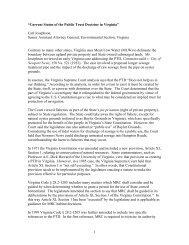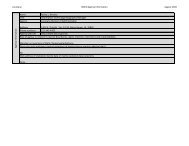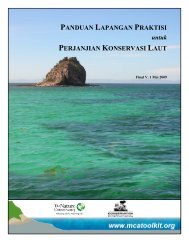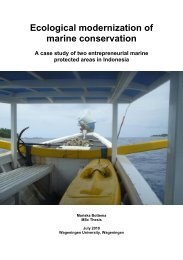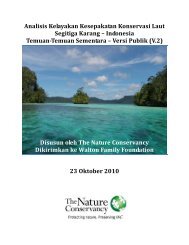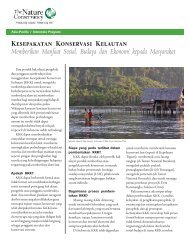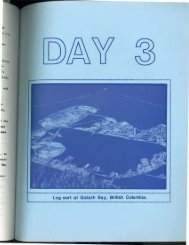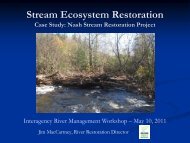Community Based Fisheries Management - Marine Conservation ...
Community Based Fisheries Management - Marine Conservation ...
Community Based Fisheries Management - Marine Conservation ...
- No tags were found...
Create successful ePaper yourself
Turn your PDF publications into a flip-book with our unique Google optimized e-Paper software.
<strong>Community</strong> <strong>Based</strong> <strong>Fisheries</strong><strong>Management</strong>
Introduction to <strong>Community</strong>‐<strong>Based</strong> <strong>Fisheries</strong><strong>Management</strong>• Our fishing communities were once sustained by many different species –lobster, codfish, herring, winterflounder, even tuna. Now, due to overfishing, advanced technology, coastal development, pollution andstricter fisheries regulations that excluded small boats, many of these historic fisheries are unavailable tolocal fishermen.• Our coastal communities are precariously dependent on few commercial species• The marine ecosystem is complex and interdependent. The loss of one species will most certainly affectothers. We all must be involved in managing our resources if we want to ensure a future for our fishingcommunities and our world.• Engaged and informed fishermen have come to believe that communities can responsibly manageresources and regain access to diverse fisheries as those stocks rebuild.• They are working toward this goal with a tool called “<strong>Community</strong>‐<strong>Based</strong> <strong>Fisheries</strong> <strong>Management</strong>”—anapproach where communities directly manage their own marine resources. This management styleprotects and sustains communities and resources alike.• <strong>Community</strong>‐based management is practiced worldwide, from Alaska to Thailand, from Mexico to NewEngland.• Some organizations like The Stonington <strong>Fisheries</strong> Alliance, The Cape Cod Commercial Hook Fishermen andothers also practice community‐based resource management. The alliance started in 1999 to introducethe concept of managing fisheries based on principles that lead to sustainability.• Habitat and fisheries restoration is part of the emerging ethic. The Zone C Lobster Hatchery in StoningtonME, or the proposed multi species shellfish aquaculture facility at Belford, NJ provides a working exampleof <strong>Community</strong>‐<strong>Based</strong> <strong>Fisheries</strong> <strong>Management</strong>. The hatcheries were initiated by fishermen and conservationgroups, and built by fishermen, as a way to learn about sustaining and protecting the resource on whichthey depend.
<strong>Fisheries</strong> Restoration EffortsStonington Maine Lobster HatcheryBuilt by and run by the lobster cooperativeBaykeeper Oyster Restoration ProjectOperated with the cooperation andInvolvement of NY and NJ Baymen
Why <strong>Community</strong> <strong>Based</strong><strong>Fisheries</strong><strong>Management</strong>?Unlike the traditional fishermen’s organizations that havehistorically been created to protect the interests that mostbusiness lobbyists deal with (allocation, keeping regulationsat a minimum, avoiding taxes, getting government pricesupports or loans), community‐based groups have more incommon with community development/social action andenvironmental groups. They do have an economic interest,but they also have an interest in protecting the environmentthat supports and surrounds their home towns.
The Need for Alternative <strong>Fisheries</strong><strong>Management</strong>Coastal fishing communities are in trouble. The sense of place and thetraditional connection of community residents to marine resources arevanishing. Current management systems are undermining theecological, social and economic basis of community sustainability. Inmany cases this has contributed to the exhaustion of resources,decreased biological diversity, and the loss of a way of life that formsthe basis of much of our history and culture. Increased absenteeownership and capital costs deny the traditional entry of futuregenerations from coastal communities. The community's knowledge of,economic dependence upon, and attachment to fisheries resources isessential to promoting a strong sense of stewardship. There is anational and an international interest in maintaining healthy, dynamicand diverse coastal communities.
Fishing <strong>Community</strong> Initiatives in <strong>Community</strong> <strong>Based</strong><strong>Fisheries</strong> <strong>Management</strong> and The Sitka Declaration<strong>Community</strong>‐based fisheries seeks to develop and implement new practices of sustainable fisheries management that areresponsive to the scale of communities, their fisheries, and their social and economic structures and dynamics.Approximately 40 U.S. and Canadian practitioners, fishermen, and community leaders gathered in Sitka, Alaska todiscuss issues, strategies, and next steps in community‐based fisheries management (CBFM). The workshop, a follow‐upmeeting to one held in October 2004 in Maine, focused on the opportunities and appetite for a broad based movementin the U.S. and Canada. The group proved to be a very powerful and motivated collection of experienced thinkers on thetopic and they rose to the occasion.Three focal groups met during the meeting:•a 'framework declaration' group declaration document,•an 'on‐the‐ground' tools and practices group,•and a U.S. Magnuson‐Stevens Sustainable <strong>Fisheries</strong> Act reauthorization group.More broadly the meeting was an opportunity to assess what these activities could sum up to and what the next stepsshould be and how these will be supported through organizations and with what funding.This ongoing effort reflects the immense nature and challenges of the issues ofcommunity scale, leadership capacity, and running "against the tide" of currentand entrenched trends in fisheries management in both the U.S. and Canada.The meeting served to catalyze west coast participation and views into the nationwide gathering.Funded by the Ford Foundation.
Proposal for Forum of Fishermen, NGO’s, and GovernmentAgencies to Explore Expansion of the Use of Sectors, Catch Share, and<strong>Community</strong> <strong>Based</strong> <strong>Fisheries</strong> <strong>Management</strong> in the Northeast and Caribbean"Wealth that is free for all is valued by none because he who is foolhardy enough to wait for its propertime of use will only find that it has been taken by another...." H. Scott Gordon (The Economic Theoryof a Common Property Resource: The Fishery, 1954)“The world’s fisheries offer a contemporary example of the tragedy of the commons. Because oceans areunowned, each fishing fleet has no incentive to conserve or replenish the fish it takes and it has every incentiveto take as many fish as possible lest the benefits of a larger catch go to someone else.” Kent Jeffreys, “Rescuingthe Oceans,” in The True State of the Planet, Ron Bailey, ed. (New York: The Free Press, 1995).
“<strong>Community</strong>-based management …. have been advocated worldwide as means to overcome overexploitation offisheries. Yet, researchers and managers are divided regarding the effectiveness of these measures. The “tragedyof the commons” model is often accepted as a universal paradigm, which assumes that unless managed by theState or privatized, common-pool resources are inevitably overexploited due to conflicts between the self-interestof individuals and the goals of a group as a whole. Under this paradigm, the emergence and maintenance ofeffective community-based efforts that include cooperative risky decisions as the establishment of marinereserves could not occur……. We found that locally crafted and enforced harvesting rules led to a rapid increasein resource abundance. Nevertheless, news about this increase spread quickly at a regional scale, resulting inpoaching from outsiders and a subsequent rapid cascading effect on fishing resources and locally-designed rulecompliance. We show that cooperation for management of common-pool fisheries…. . can emerge, evolve rapidly,and be effective at a local scale even in recently organized fisheries. Stakeholder participation in monitoring,where there is a rapid feedback of the systems response, can play a key role in reinforcing cooperation…….increase of local fishery stocks may attract outsiders who, if not restricted, will overharvest and threaten localgovernance. Fishers and fishing communities require incentives to maintain their management efforts. Rewardinglocal effective management with formal …. governance recognition and support can generate these incentives.”Richard Cudney-Bueno and Xavier Basurto
Local <strong>Management</strong> of the Commons“<strong>Community</strong>-based management of the marine reserve network relied primarily on a suite of simple rules and means ofenforcement, leadership of key individuals, meeting venues that allowed for social and ecological feedbacks, and capitalizing onthe region's physical and environmental characteristics. Formal and Informal Rules and Sanctions Fishers designed, monitored,and enforced three main forms of rules:•resource-based rules (snail fishing banned June and July;•fishing banned within reserves),• monitoring rules (mandatory participation in and financial contributions for monitoring)•and administrative rules (mandatory: participation in cooperative meetings,•monthly financial contributions to the cooperative, and timely provision of paperwork for cooperative).These rules and their sanctions were built primarily on foundations of trust and reciprocity and concerns for the group's wellbeing. Hence, the most effective and usual form of enforcement relied on variations of peer pressure and public shame. This, inessence, could ultimately threaten the rule-breaker's reputation and his social bonds and norms—also known as social capital—with the rest of the members of the group. These were de facto sanctions with no legal standing under the statutes of thecooperative. While other formal sanction types were developed, they were either largely avoided, often changed, or were appliedlast. On occasions, local government officials provided enforcement support that was based entirely on the rapport built betweenfishers and officials, as reserves were yet to be formalized by the government. Formal and informal sanctions by rule typedevised by local fishers.To exemplify this, 100% of fishers interviewed said that they trusted that other fellow fishers for the most part respected thereserves. Similarly, when asked the open ended question “In what way would breaking cooperative rules affect you?” all answersfell into three categories: 1) personal guilt and sense of betrayal to the group, 2) concern of the rest of the group's opinion aboutone's actions, and 3) concern over the possibility of losing trust and friendship. If someone within the group cheated, the firstapproach of members of the cooperative was to tap into the personal guilt associated with the event. Often, it was onlynecessary to bring the case to the attention of the group without singling out specific people. This way, the informer's reputationwas also protected and he would not be labeled as an accuser. “Accuser” is one of the worst labels a commercial diver can have,largely because it can undermine his network ties and reliance on these ties when in need of any help. During interviews, whengiven a choice to express what would be worse, for the group to label you as an accuser or as a cheater, practically all diversfound it impossible to make a choice. They were both seen as equally detrimental.” Richard Cudney-Bueno and Xavier Basurto
SectorsOpen access to fisheries leads to overuse and decline in the fish stock, and in the catch.Generally, the response by resource managers has been to limit new access, but to permitthose already permitted to continue to use the fishery. This rarely works. The next step is tolayer additional technical constraints, with the intention to limit the catch of those who are still fishing.Or, hard caps are imposed on the fishery, which leads to a race by individuals to fish out the limit.What the economists think we should do: Eliminate the "commons" of the fishery, and create propertyrights (or 'quasi-property rights') in order to create incentives for stewardship. But how? Can't fencethe water. Create ITQs (individual transferable quotas) and allocate them to cooperatives.Limit how many fish are caught, but let people choose how and when to catch them. This lets fishermenbe flexible and efficient about when and how to fish.Sectors are groups of permit holders (fishermen), voluntarily joining together to manage a combinedallocation of fish. To be in a sector, you've got to sign a binding contract, and as a group you must notexceed the allocated limit. Sectors get to decide how to ration the allowable fish catch among themembers. There's no geographic limit or vessel type limitation on a sector.Sectors are simpler, more flexible, and more responsive than current regulatory structure. Fishermen havesome assurance that they won't be punished or hurt by the bad actions of fishermen outside the sector –those who behave right get to keep their allocation. (Will they really? We don't know, exactly, because ofcourse the whole fishery must be protected). Sectors might also help with marketing, bargaining, andgroup buying.For the first time in decades, change is on the horizon for New England’s groundfish fleet. On June 25, theNew England Fishery <strong>Management</strong> Council approved an amendment to the current management plan forground fish stocks (including cod, haddock, and flounder) that will offer fishermen a better way to do business.Fishermen will have the opportunity to work in community-based harvesting cooperatives, called Sectors,instead of under complex and often-ineffective federal restrictions. By allocating each Sector a certain amountof fish and allowing more flexibility in how those fish are harvested, implementing this model will help rebuildfish stocks while creating safer fishing trips, reduced fish waste, and increased profits for fishermen.Currently under review by the National <strong>Marine</strong> <strong>Fisheries</strong> Service, Amendment 16 would be implementedstarting in May 2010. CCCHF
Catch Shares<strong>Fisheries</strong> management regimes take many forms, but most fail to designate shares of the catch. This failurecreates strong incentives for individuals to maximize their share without regard to long-term sustainability, becausethe benefits of conservation actions do not accrue to individuals. The competition to maximize catch usuallyentails excessive capital investments in fishing vessels and gear and intense fishing pressure, resulting inoverfishing, high bycatch rates, and the use of large, efficient types of gear that can harm habitat. Managersrespond by increasing regulations, but this often exacerbates perverse incentives. In addition, many fisheries couldbe producing more value than the current system permits, i.e. large quantities of fish are landed during shortseasons, forcing fishermen to sell for low prices. <strong>Conservation</strong> and economic problems facing fisheries can beaddressed in an integrated way, by designating access privileges (specifying shares of the catch) to individuals,harvest cooperatives, fishing sectors, communities, or other appropriate entities. Designated Access Privilege(DAP) systems demonstrably end the competition to maximize catch and often result in better conservation andfinancial performance. The cost of implementing these systems can be relatively high and has been a barrier tobetter management. However, this doesn’t have to be so. <strong>Fisheries</strong> could accept investments from a variety ofsources and use a portion of the increased financial performance to repay recoverable grants and loans. The keyto protecting fish stocks, habitats, and the communities that depend on them will be to implement DAPs that areappropriate for each fishery or community, making investments in sustainability, and creating financingmechanisms that are themselves sustainable, drawing on the increased value that DAP fisheries can produce.Rod Fujita and Kate Bonzon Environmental Defense, 5655 College Avenue Suite 304, Oakland, CA 94618, USA
Purchasing PermitsIn 2008The Cape Cod Commercial Hook Fishermen’s Alliance launched the Cape Cod <strong>Fisheries</strong> Trust (CCFT) to respond tomounting threats to fish populations, fishermen and their communities. CCCHF is raising funds and buying cod, scallop andlobster permits to make sure there is a next generation of fishermen on the Cape. CCCHF’s work with local fishermen hasforged a new and promising model for other fishing communities that are working to save their fish, their fleets and preservea way of life.The Cape Cod <strong>Fisheries</strong> Trust is a home‐grown idea to buy fishing permits and keep them in our community. LocalFishermen will sign binding lease agreements with the Trust and fish with traditional gear and small boats. With a year underits belt, the Trust has exhibited market savvy, managementexcellence, creativity, and business acumen. There is no question this approach has helped to stem the tide of dwindlingfishermen in our community. For the past 3 years, we have observed a threat to our fishing community as permit prices riseand bigger fishing businesses acquire small boat fishing permits. The effect is threatening to remove our fishing heritageforever.Recently, there have been three material developments regarding commercial fishing permits that require us to seek tobuild out the CCFT program as quickly as possible. The CCFT is asolution that will protect our fish, the fishermen and, mostimportantly, our fishing community. Through the success of this program we hope to be able to ensure the long‐term survivalof several commercial fishing enterprises. The time for action is now and the risk of inaction could be catastrophic.“PENOBSCOT EAST LAUNCHES FISHING PERMIT BANK AT JULY 20 PRESS CONFERENCE”Maine Senator Dennis Damon, Chair, <strong>Marine</strong> Resources Committee, and Speaker of the Maine House Rep. Hannah PingreWere In Stonington on July 20th to attend a press event announcing announce a historic step by Penobscot East ResourceCenter towards recovering the groundfish fishery of Eastern Maine.http://www.penobscoteast.org/documents/PERMITBANKPRESS.pdf
Can <strong>Community</strong> <strong>Based</strong> <strong>Fisheries</strong> <strong>Management</strong> WorkFor Fishermen in Places as Diverse as Maine, Massachusetts,New Jersey and Puerto Rico?
http://www.penobscoteast.org/http://www.midcoastfishermen.org/http://vimeo.com/5755011http://www.ccchfa.org/Dodge Draft Bayshore Resource CenterProposal.pdfhttp://www.vcht.com/Cooperativo de Pescadores deVieques
Belford and ViequesBelford, New Jersey and Vieques, Puerto Rico appear to be a different as any two places could be. However when you takea second look you might find that the communities and their fishermen have more in common with each other, and withthe communities and fishermen in Maine and Massachusetts. Belford is an anomaly in New York Harbor. It is the last commercialfishing port, and the oldest fishing cooperative in the region. Encroached upon by development, and hampered by pollution and acomplex regulatory system, the fishermen are disillusioned. Several generations of families have fished from Belford, but a newcondominium development, a commuter ferry terminal, and a inadequate community development plan have increased the number offishermen who do not want to see their children follow them into the fishery.In 1975, the fishermen of Vieques formed the Vieques Fishermen’s Association. The group was not created to oppose the presenceof the US Navy in Vieques, but rather to address more immediate problems such as the lack of a dock and a proper location to clean,process and sell fish. Most fishermen in Vieques used fish traps as a mainstay of their art. These fish traps, locally called nasas,were in those day made of chicken wire and reinforced with saltwater-resistant wooden sticks cut from local trees. They are generallyset in 60 to 150 feet of water and are attached to a line, which leads to a floating buoy about one foot in diameter and are hauled byhand about once every two days.A major problem for the Viequense fishermen was that the large naval ships using Vieques for target practice and mock battles wererunning over the fish trap buoys and cutting the lines leading to the traps. When this happens, the traps, which represent a good dealof time and money to the fishermen, are lost forever. One night in 1977, 131 fish trap buoys were cut.It was at this juncture that the Vieques Fishermen’s Association entered the political arena. The Association brought a lawsuit againstthe United States Navy for the loss of these traps. Hoping to squash the case before it went to trial, the Navy asked for, and wasgranted, a change of venue, so that the trial would be heard in Virginia instead of Puerto Rico. This was a severe problem for thefishermen, who lived simply did not have money for such luxuries as airlines and travel expenses.Nonetheless, the fishermen were able to get together the airfare and sent a delegation including the president of the Association,Carlos (Taso) Zenón. They found lodging in the cheapest of motels, ate as economically as possible, and to the surprise of Navyattorneys, appeared at court. At the hearing, the judge was sympathetic to the fishermen. He admonished the Navy lawyers for theirtactic of forcing the poor fishermen who he knew had little money and who spoke Spanish to travel to the mainland United States toappear in court. The judge found for the fishermen and the Navy had to reimburse them for the lost fish traps.However today the fishermen are once again struggling, this time because of increased tourism and shoreline development. Inrecent years fishermen have come to believe that a sustainable fishery that includes lobster aquaculture and an alliance with theVieques <strong>Conservation</strong> and Historic Trust is the only way to preserve their culture, community, and livelihood.
Next Steps•Create and organization called the Bayshore Resource Center to address theissues presented here in the proposal to the Dodge Foundation and as anadvocacy organization for community based fisheries management• Determine the interest of fishermen from Stonington and Port Clyde Maine,North Chatham, MA, Belford and Highlands, NJ, and Vieques PR in participatingin a forum and ongoing cooperative activities to promote community basedfisheries management, sectors, catch share, permit purchasing, and otherconservation and sustainability measures.•Find funding for this new organization, develop a diverse board and advisorycommittee made up of fishermen, local and regional conservation organizationsengaged in fisheries issues, and local, state, and federal government agenciescurrently invoved with fisheries management.•Convene a meeting during 2010 in Belford for practitioners, fishermen, andcommunity leaders to discuss issues, strategies, and next steps in communitybasedfisheries management (CBFM). The workshop, a follow-up meeting toones held in Maine and Alaska.



